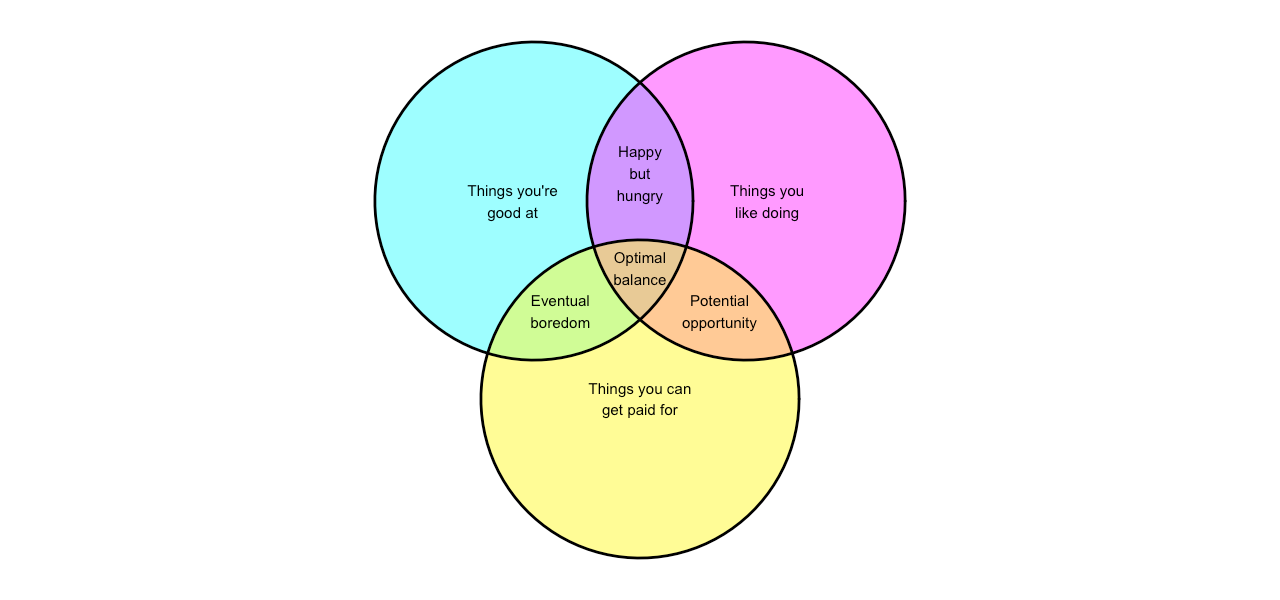The three key facets of any career are hopefully pretty self explanatory:
- Things you’re good at
- Things you like doing
- Things you can get paid for
If you can find a career that exists at the intersection of all three I think you’ll be pretty happy.
Life’s rarely that simple though, so let’s take a look at the two-set intersections to see where a career can get more nuanced.
Happy but hungry
This is the realm of hobbies and fun side projects, where the things you’re good at and enjoy aren’t things that are going to make you money. It’s a sad fact of life that few of us are in a position to exist in this space for long.
We all have bills to pay and many of us have families to take care of, as well as a million and one other draws on our finances. For the vast majority of us, money is security. We all need somewhere to live and food to eat and those things cost money.
Eventual boredom
This is what happens in your career when you’re perfectly capable of doing a thing that earns you money, but it’s not something that you particularly enjoy or that motivates you. Work that inspires us to get up in the morning isn’t always easy to come by, but if you don’t have something to look forward to, the rot quickly sets in.
Potential opportunity
At the intersection of “things you enjoy” and “things you can get paid for”, sits opportunity. You might not feel like you’re particularly good at this thing yet, but hopefully that will come with time. Any opportunity is, of course, also a risk and there’s a chance you’ll never become good at it, but if you enjoy it enough to put the work in, chances are you’ll become good over time.
The truth
Of course the truth is always more nuanced than any Venn diagram can convey. The fact of the matter is that any career of sufficient duration will almost certainly go through all of the facets outlined above. This is in no way unusual.
Sometimes, you’ll go through all of these stages over the course of years and sometimes all in one day. The key is to always try to find a way back to the centre.
Sometimes your career, or elements of it, may be less than inspiring. Perhaps your dream career (professional ukulele player?) isn’t going to pay the bills. Maybe you’re stressed out because you don’t think you’re particularly good at what you do, or you’re not getting better at it fast enough. Whatever the situation, know that this isn’t unusual. We all go through it.
On top of all of that, your career isn’t some static thing. It’s a moving target. Your interests and aptitudes change over time. The things that excite you today are probably not the same as they were a few years ago. Try not to think of your career as a linear journey when it’s always going to be much more of a roller coaster ride!
Simplifications like the Venn diagram above offer us a useful way to reason about a complex world, but they are just that; simplifications. However complex you career is, I hope you can find the optimal balance that works for you and remember not to put too much trust in simplifications.
Update
At some point after I first published this somebody pointed out how close it is to the Japanese concept of Ikigai. I first heard about Ikigai some years before I wrote this and had obviously forgotten about it, but you should definitely read about that too if you’re interested.
Bonus Venn diagram code in R
This is the R code used to generate the Venn diagram at the start of this post.
library(ggvenn)
a <- list(s1 = c("Things you're\ngood at",
"Optimal\nbalance",
"\nEventual\nboredom",
"Happy\nbut\nhungry"),
s2 = c("Things you\nlike doing",
"Happy\nbut\nhungry",
"Optimal\nbalance",
"\nPotential\nopportunity"),
s3 = c("Things you can\nget paid for",
"Optimal\nbalance",
"\nEventual\nboredom",
"\nPotential\nopportunity"))
ggvenn(a, show_percentage = FALSE,
fill_color = c("cyan", "magenta", "yellow"),
show_elements = TRUE,
set_name_color = "white")
